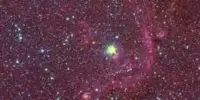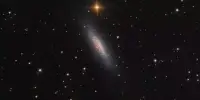The North America Nebula is a large emission nebula located in the constellation Cygnus, about 1,600 light years away from Earth. It is named after its resemblance to the continent of North America, which can be seen in its shape.
This Nebula also known as NGC 7000 or Caldwell 20, is an emission nebula in the constellation Cygnus, close to Deneb (the swan’s tail and the brightest star in the constellation). The nebula’s shape is similar to that of the North American continent, complete with a prominent Gulf of Mexico.
The nebula spans an area of about four times the size of the full moon in the night sky, and it is one of the brightest and most recognizable emission nebulae in the sky. The reddish color of the nebula is due to ionized hydrogen gas that is being energized by nearby young stars. The North America Nebula is also home to a number of dark nebulae, which appear as dark patches against the glowing background of the nebula.

History
William Herschel, observing from Slough, England, on October 24, 1786, noted a “faint milky nebulosity scattered over this space, in some places pretty bright.” On August 21, 1829, his son John Herschel cataloged the most prominent region. It is designated as NGC 7000 in the New General Catalogue, where it is described as a “faint, most extremely large, diffuse nebulosity.”
In 1890, the pioneering German astrophotographer Max Wolf noticed this nebula’s characteristic shape on a long-exposure photograph, and dubbed it the North America Nebula.
Distance and size
The North America Nebula can be observed with the naked eye under dark skies, but it is best viewed with binoculars or a telescope. It is a popular target for astrophotography, and many stunning images of the nebula have been captured by amateur and professional astronomers alike.
Because there are few precise methods for determining how far away an HII region is, the distances to North America and the Pelican nebulae were contentious. Most astronomers accepted a value of 2,000 light years until 2020, though estimates ranged from 1,500 to 3,000 light-years. However, in 2020, the Gaia astrometry spacecraft measured the distances to 395 stars in the HII region, resulting in a distance of 2,590 light-years (795±25 parsecs) between the North America and Pelican nebulae. The HII region Sh2-117 as a whole is estimated to be 140 light-years across, with the North America nebula stretching 90 light-years north to south.
















